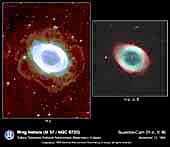Press Release
Subtle halos about Ring Nebula
September 16, 1999
 Low Res. (87 KB) High Res. (345 KB) |
Object Name: Ring Nebula (M57, NGC 6720) Telescope: Subaru Telescope / Cassegrain Focus Instrument: Suprime-Cam Filter: H alpha(0.65micron), B(0.45micron), V(0.55micron) Color: Blue (B), Green (V), Red (H alpha) Date: UT1999 May 14, 23; June 15 Exposure: 25 min (H alpha), 6 min (V), 40 min (B) Field of View: 3 x 4 arcmins Orientation: North up, east left Position: RA(J2000.0)=18h53m36s, Dec(J2000.0)=+33d02m00s (Lyra) |
The planetary nebula M57 (NGC 6720), or the Ring Nebula as it is most commonly referred to for obvious reasons, lies about 1600 light years away from the Earth. The name "planetary nebula" given to this class of objects is due to the fact that many of them appear disc-like, similar to how the planets in our Solar System appear when viewed through a telescope. In reality, planetary nebulae are stars at the point of death.
The bright ring of M57 is composed of a doughnut-shaped cloud of gas illuminated by a very hot central star. Past observations have revealed that the bright ring is surrounded by a faint outer halo. Because the halo is so faint, previous observations have in general been insufficient to allow us to develop a detailed understanding of its nature.
Recent observations obtained using Suprime-Cam attached to the Subaru Telescope have successfully imaged in great detail both the bright inner portion of the nebula and the faint outer halo of M57. It is expected that these observations will improve our understanding of how the Ring Nebula came to be, including insight into the gas flow from the aging star at the center of the nebula when it was in its "red giant" phase.
<Planetary Nebula>
The behavior of a star at the end of its life depends on
the mass of the star. Stars with a mass from 0.8 to 8 times
that of the Sun become huge red giants after burning all
the hydrogen at their cores. During this phase, most of
the gas towards the star's surface expands outward. As the
surface gases become rarefied, the central part of the star
contracts, becoming a high density "white dwarf".
The contraction raises the surface temperature of the white
dwarf to several tens of thousands of degrees. At such high
temperatures, the star emits high energy ultraviolet light.
A planetary nebula appears when the expanding gas released
during a star's red giant phase is illuminated by the ultraviolet
light emitted by the central white dwarf. The ultraviolet
light heats and ionizes the gas, causing it to glow. The
shape of a planetary nebula depends on the distribution
of the gases that were released, the strength of the ultraviolet
radiation from the white dwarf, and the particular view
we have of the nebula from our vantage-point here on the
Earth. This is the reason why planetary nebulae come in
a wide variety of shapes.
Left Figure:
This false-color image shows an observation made in the
light given off by hydrogen atoms (centered on the "H_alpha"
line at a wavelength of 6563 Angstroms). We see that the
bright inner ring is not uniform and in addition there is
a complex extended outer structure or "halo".
The major-axis of the bright ring measures about 0.7 light
years. There are two bright stars seen within the ring:
the central star is the white dwarf that illuminates the
Ring Nebula; the other star is an unrelated object along
the same line of sight.
This is the first time the outer halo associated with M57 has been observed so clearly. The figure shows that there are two components to the outer halo: a brighter inner part within which there are many loops; and a fainter detached outer part. While the ring and the inner halo appear oval, the outer halo is almost circular. The major-axis of the inner halo measures about 1.2 light years and the diameter of the outer halo is about 1.8 light years. Besides the loops and filaments within the inner halo, we also see many small clumps called "knots" within both the inner and outer halos.
Planetary nebulae like the Ring Nebula are often described as having a fairly simple structure, generalized as an elliptical shell. We clearly see from the new Subaru Telescope observations of the outer double halo that their true structure is considerably more complex.
Right Figure:
This figure is composed of three separate images, each taken
through a different color filter and combined to recreate
the scene in color. The original image was then processed
using a "Maximum Entropy" method to enhance the
image sharpness. The process makes the outer halos become
faint but reveals a great wealth of delicate structure within
the bright ring.
Supplement (JPG, 72 KB) / Supplement (PDF, 602 KB)